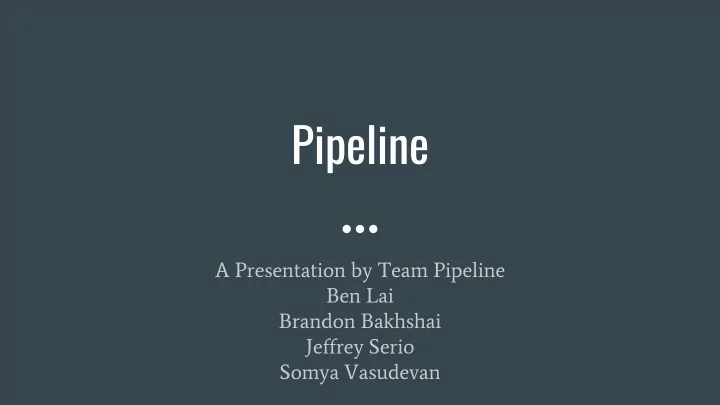

Pipeline A Presentation by Team Pipeline Ben Lai Brandon Bakhshai Jeffrey Serio Somya Vasudevan
What is pipeline Pipeline is an asynchronous programming language that uses an event-driven architecture. Pipeline’s event-loop is powered by libuv, the same library used by nodejs to implement it’s asynchronous architecture. Pipeline uses the idea of a pipe as a kind of user-friendly asynchronous thread-like interface, which allows the user to write a block of synchronous statements and execute that block asynchronously from the rest of the code in the program.
Quick-start guide
Types Int Float String Struct Bool File
Variable Declaration and Assignment Type ID; or Type ID = expr;
Strings String supports the following operations: len( string ): returns the length of a given string cmp(string, string): compare two given strings and returns True when equal and False otherwise sub(string1, string2): returns True if string2 is a substring of string1, return False otherwise String concat with “$”: “Hello” $ “ world” = “hello world”
“hello world” 5 false false
Functions Function declaration: Function type ID(formals){stmts} Function call: ID(formals)
Structs The structs in pipeline Struct Definition are declared and used the exact same way as struct <struct_name> { [statements…] the structs in C. The only }; type that cannot be declared as part of a Struct declaration: struct is the List type, because List is not a struct <struct_name>; complete type. Structs Struct use: also cannot be declared and initialized in the Prints 6 <struct_name>.<struct_variable> same statement
List Singly linked list operates on the heap. List decl: List operations: addleft , addright, popleft, access, free_list
File I/O File declaration: For file IO a File type is first File f; declared and then initialized. Initialization opens a file in a File initialization: given mode, to be used for init_file_obj(f, file_name, file_mode); reading and writing to files. The supported file Supported operations: operations are read line from function string string fread_line(File f); the file, read n bytes (up to reads a line from a file and returns a string. 4095) from the file, and write function string freadn(File f, int n); reads n bytes from the file up to 4095 a string to the file. After the bytes. user is finished he/she must function void fwrite_string(string s, File f); use close_file(file_obj) to writes a string to a to the file close the file. function close_file(File f); closes the file
Control structures for , while, if, else
Pipes Pipes are created to enable asynchronous programming using the event-driven architecture. Ideally the code that is blocking, and the variables dependent on it, go inside a pipe. Multiple pipes can be created in the program.
Example Program
Routing Pipeline language supports the following HTTP functions - LISTEN, GET, PUT, POST. All these functions are supported only inside a pipe. The Listen function has to go first inside the pipe before anything else, and the rest of the HTTP functions require LISTEN to be present for them to execute. The listen function takes a string (IP Address) and an integer (the port number). The other HTTP functions take “GET”, “POST”, “PUT”, “DELETE” as the 1st argument; the route as the 2nd argument; and the callback function(function name is passed as string) as the 3rd argument.
Examples:
The Pipeline Translator
The Translation Process
Inside the Translator
The Translator Pipeline Code: C Code:
Recommend
More recommend